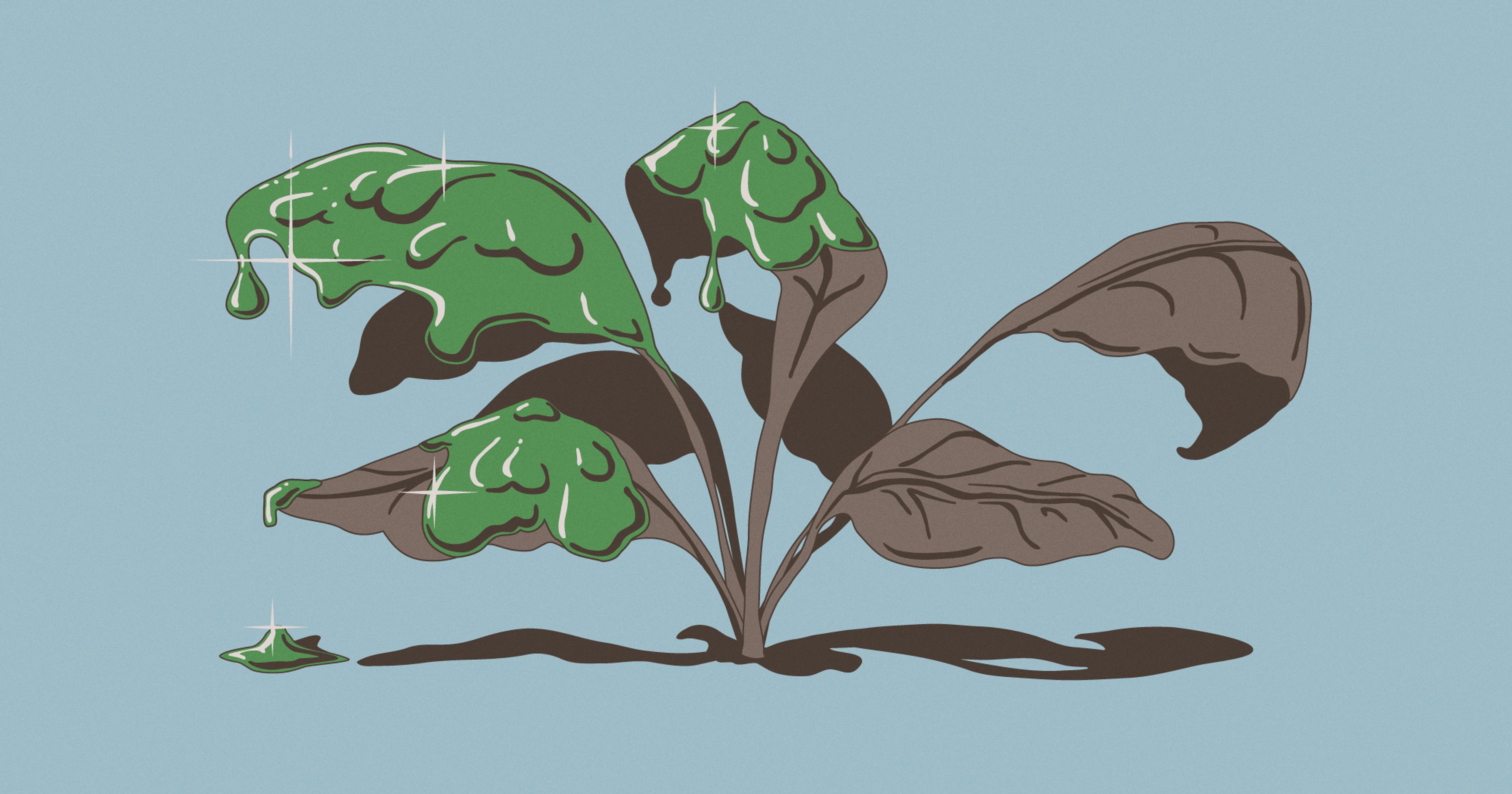Algae sourced from algal blooms has shown much promise as a biofertilizer, potentially replacing the chemicals that cause … algal blooms.
In many parts of the country, it’s become a reliable sign of summer: brilliant blooms of blue-green algae that suffocate wildlife, poison pets, and harm human health.
But when soil scientist Krish Jayachandran assessed the state of okra growing in the greenhouse at Florida International University, he discovered that same destructive algae could do something else: nourish plants.
Blue-green algae — the common name for a group of microbes known as cyanobacteria — are the most ubiquitous photosynthesizers on the planet. They’re also the most ancient: Roughly 2.4 billion years ago, photosynthesizing cyanobacteria created the oxygen-rich atmosphere on which life now depends.
Yet in the more recent past, cyanobacteria have become a threat: It’s not all dangerous, but some species produce toxins. And as the fertilizers applied to crops, lawns, and golf courses have trickled into waterways, they’ve boosted the growth of toxin-producing cyanobacteria living in that water, prompting lethal algal blooms. Cyanobacterial blooms — which also reduce water quality and suck the oxygen from aquatic ecosystems — are now found in freshwater bodies in all 50 states. And, due to climate change-driven temperature increases, those blooms are happening more frequently.
This is true in Florida, where population growth and agricultural runoff have contributed to the foul-smelling mats of cyanobacteria that consistently appear on lakes once the weather turns warm. “Nitrogen and phosphorus get into the system … and [cyanobacteria] take it as fuel,” said Jayachandran. “It’s a major, major problem.”
In some lakes, the situation is severe enough that officials have started attempting to remove some of the algae. Watching one of those harvests unfold on Florida’s Lake Jesup, Jayachandran wondered: Could cyanobacterial blooms — one of modern agriculture’s pernicious side-effects — also help solve the problem?
The initial results of that research, published in Environments in February, are promising.
For the research, a team of scientists took five-gallon buckets of cyanobacterial slurry skimmed from Lake Jesup and dried the slurry until it was solid enough to be applied to soil.
The resulting growth, plant vigor, and yield for okra, when compared to a plot without any fertilizer, were striking, Jayachandran said, and results were also better than those in plots using synthetic fertilizer. The cyanobacterial biofertilizer also had very high levels of iron — an important discovery for South Florida’s naturally iron-deficient soils.
“Nitrogen and phosphorus get into the system … and cyanobacteria take it as fuel. It’s a major, major problem.”
Jayachandran said cyanobacterial biofertilizer isn’t entirely new: It has a long history in South Asian countries, where the (non-toxic) cyanobacteria that grow naturally in rice paddies — help nourish crops.
But in the United States, interest in cyanobacteria’s positive side — and the number of projects investigating cyanobacterial fertilizer — is growing, as the environmental toll of synthetic fertilizers made from nitrogen and phosphorus becomes apparent.
Worldwide, less than half the nitrogen fertilizer applied to crops is actually absorbed by plants. The remainder either washes off into waterways, fueling algae blooms and polluting our water supply, or it breaks down in the soil, producing greenhouse gases. Meanwhile, the production of nitrogen fertilizer requires very high heat and pressure, producing roughly two percent of global carbon emissions.
Ruanbao Zhou, professor of molecular microbiology at South Dakota State University, said cyanobacteria could drive more sustainable agricultural practices. Because some species of cyanobacteria naturally fix nitrogen from the atmosphere — pulling it out of the air and transforming it to a form where it’s usable by plants — they offer an alternative for synthetic fertilizer.
For Zhou’s research, he collected cyanobacteria from the South Dakota Badlands (the bacteria are also found in soil) and grew them in a lab. The results promoted growth in wheat, though not as well as synthetic fertilizers. But unlike synthetic fertilizers, they could be produced at room temperature. “[Bio]fertilizer is a very promising practical application,” he said. Along with a nutrient source, “you just need water and sunlight.”
Still, making cyanobacterial biofertilizer a viable option for growers is complex — not least because cultivating algae that can unintentionally bloom out of control comes with real risks.
“The technical issues we experienced are surmountable, it’s just a question of how.”
Steve Ela, a fourth generation fruit grower with a 100-acre orchard in Western Colorado, has trialed cyanobacterial biofertilizer on his peach trees. Ela was drawn to the opportunity as a way to avoid sourcing nitrogen off-farm. As an organic grower, he said, he’s always pursuing a more balanced and self-contained operation.
“This was an approach to being able to grow nitrogen in a different way,” said Ela. “If we can find ways to extract nitrogen from the atmosphere naturally … and do it on-farm or distributed, it makes for a more resilient agricultural system.”
The trial, which Ela did with researchers from Colorado State University, involved growing cyanobacteria on the farm in tanks specially designed for algae cultivation, and applying it through the farm’s irrigation system.
The results were intriguing, said Ela. Nonetheless, it didn’t make commercial sense to continue, as it was too difficult to keep the cyanobacteria growing.
Michael Massey, an environmental scientist who was part of the Colorado State team conducting the cyanobacteria research, said producing large amounts of cyanobacterial biofertilizer was a hurdle researchers struggled to get past.
The bacteria, which the team sourced locally from the soil, grew well (almost too well, Massey said) in bioreactors in Colorado State professor Jessica Davis’ garden, or in tanks. But their populations would inevitably crash — meaning they’d suddenly die off, after growing rapidly — limiting scientists’ ability to scale up the system. Nonetheless, Massey said the promise of cyanobacteria is still there, especially for those without ready access to synthetic fertilizer.
“The technical issues we experienced are surmountable, it’s just a question of how,” he said. “That’s probably going to take more than a few people working in a professor’s backyard.”
One emerging option is to use wastewater from municipal systems or agricultural runoff to provide the nutrients that boost cyanobacterial growth.
Adriana Alvarez, who studied cyanobacteria as an effective replacement for urea in the growth of spring wheat for her PhD at the University of Minnesota, agrees that the scaling and distribution of cyanobacterial biofertilizer will need to be addressed.
She said one emerging option is to use wastewater from municipal systems or agricultural runoff to provide the nutrients that boost cyanobacterial growth — using the same inputs that fuel unchecked algal blooms in the wild to create a stable supply for agriculture. But despite the growing interest in cyanobacterial biofertilizer, Alvarez said there is still a need for more research, including on safety (cyanobacteria grown on wastewater may produce toxins) and economic feasibility.
“These are alternatives that we can explore, to guarantee we have a supply of nitrogen for our crops, and guarantee that we are producing it in a sustainable way,” she said.
Inadvertently introducing toxins is a real risk. In 2017, for instance, Canadian researchers flagged cyanobacterial contamination of irrigation water for food crops as an “emerging public health issue.”
That’s why researchers, like those at Florida International University, are being cautious. For the cyanobacteria produced from agricultural runoff in Lake Jesup, Jayachandran said the research team has been testing the slurry for toxins, to make sure they’re not adding any to the soil. (Once in the soil, other microbes would eventually break down those toxins, Jayachandran said, but they’re playing it safe regardless).
Researchers are now expanding the biofertilizer work to trials with three urban and semi-urban farms in and around Miami.
Given the number of algae-clogged waterways countrywide, Jayachandran said, there is potential for this kind of system to be implemented elsewhere, turning runaway algal blooms into a resource for a more balanced agricultural system.
Convincing farmers to take it on could be its own challenge, however. In a 2023 survey by South Dakota State University researchers, less than a fifth of Midwest growers reported using biofertilizers from algae or bacteria to reduce fertilizer use (though of course, cyanobacterial biofertilizers are still an emerging tool in North America).
Yet those same farmers reported the greatest interest in biofertilizers as a long-term solution — suggesting that in those slimy mats, there’s the seed of a sustainable future.










